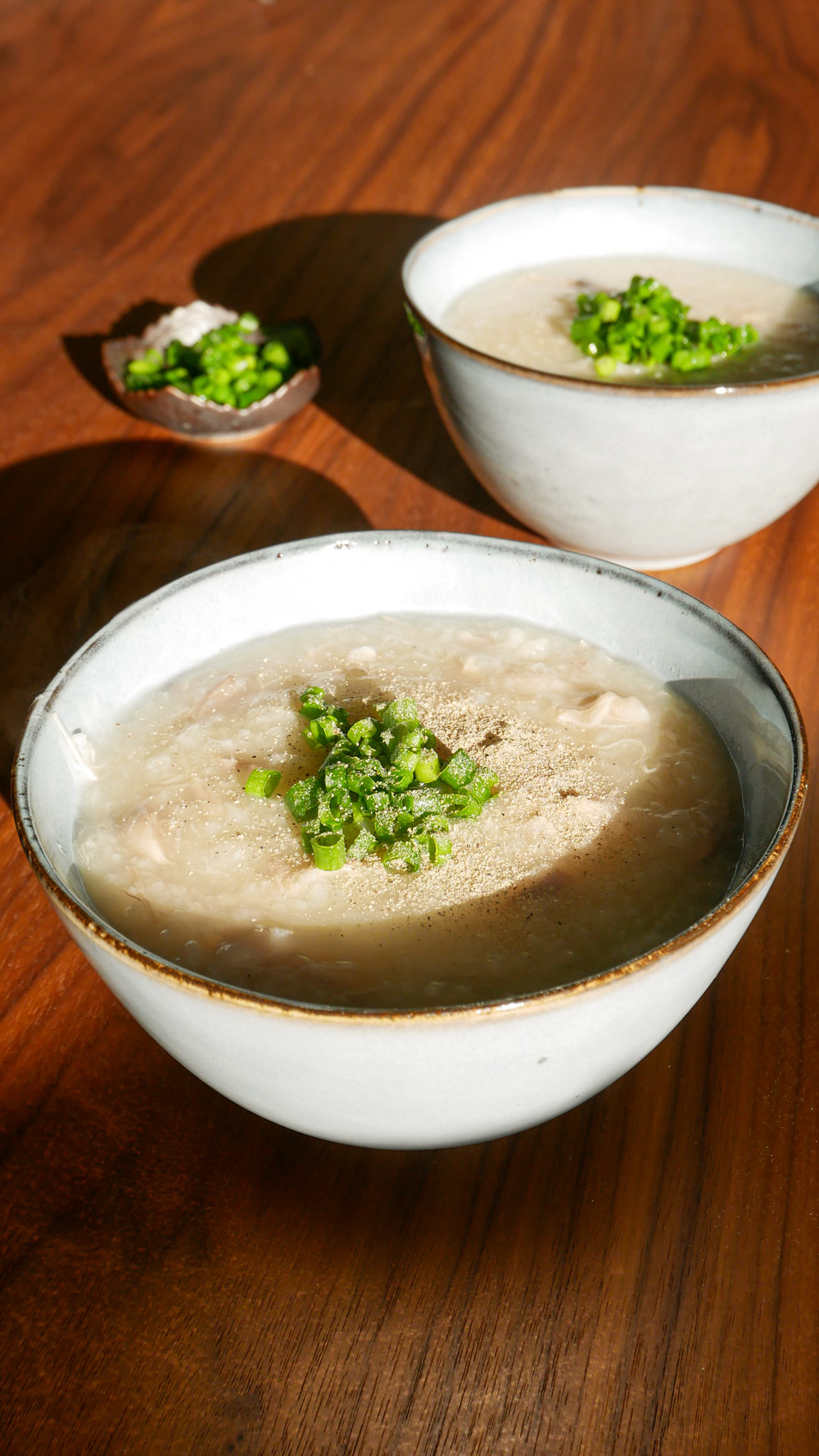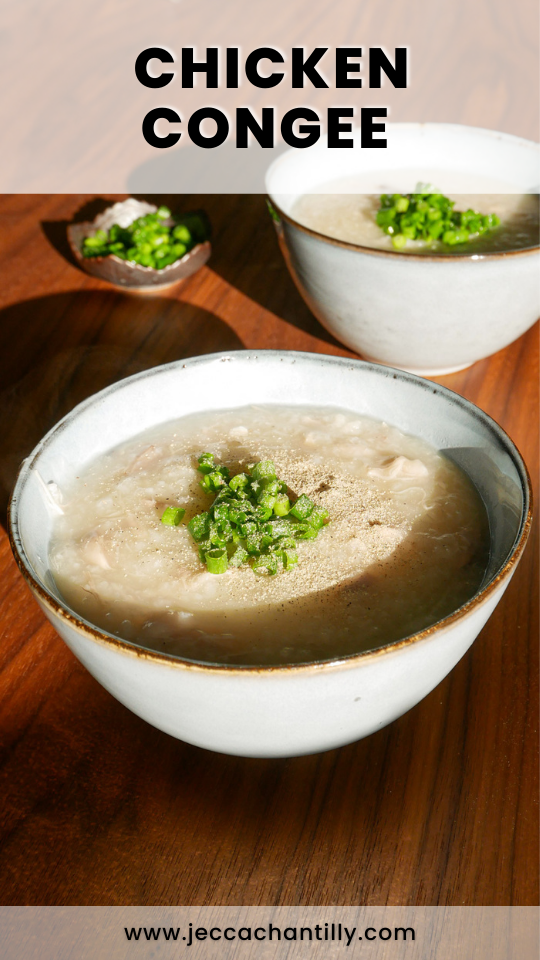Chicken congee (jook/juk) or dakjuk is my ultimate comfort food.
Congee, or ‘jook’ in Korean, is typically eaten when you’re sick, so my mom, who is Korean, would make this whenever I was feeling under the weather. In Chinese culture, though, specifically in Hong Kong, where my dad is from, congee or ‘jok’ is commonly eaten for breakfast with a side of fried crullers.
I think it’s pretty cool how we are all so different culturally but share so many similarities in food. Almost every culture has its own version of congee, and every family has their own rendition of this dish.
Growing up, my mom would make this for me whenever I was sick, but now, I can do the same for her and the people I love!
Why you’ll love this recipe
The best thing about this fish is its simplicity. All you need are rice, chicken drumsticks, and seasonings, and you have a hearty and comforting dish. But don’t be fooled by its simple ingredients because this chicken congee recipe is bursting with flavors.
Par-boiling the chicken in mirin ensures it has a delicious umami and sweet taste in every bite. Making your chicken broth from scratch also makes a big difference from using a store-bought one since you can control what ingredients to use and adjust its taste.
For this recipe, I used garlic, onion, ginger, and scallions together with the chicken. It creates a wonderful medley of umami and soothing flavors that you won’t resist asking for a second helping of congee!
Ingredients & Substitutions
Chicken drumsticks: chicken is the highlight of this dish because it adds a filling protein. If you like, you can also substitute drumsticks for chicken thighs.
Mirin: parboiling the chicken with mirin helps eliminate the odor and scum. You can also substitute it with vinegar.
White rice: congee won’t be complete without rice because it makes it hearty. Feel free to use long or short-grain rice for this recipe, such as jasmine or basmati rice.
Medium onion: onion adds an umami flavor to the congee. You can use white, yellow, or red onion for this dish.
Garlic cloves: garlic cloves go well with the flavors of the onion. In a pinch, you can use garlic powder, but the flavors won’t be as intense.
Ginger: ginger brings an invigorating kick to balance out the flavors of the congee. As a last resort, you can use ground ginger, but the flavors will be less potent.
Scallion: scallion enhances the flavors of the onion and garlic, adding a touch of color as a garnish. You can replace it with spring onion, chives, or leeks.
Water: water is the base for the broth and helps loosen the congee. Feel free to adjust depending on your preferred consistency.
Salt: salt adds flavor to the congee so it doesn’t taste bland. Feel free to adjust according to taste.
White pepper: white pepper helps enhance the overall flavors of the congee. You can also use black pepper as a substitute.
Ingredient variations/additions
If you want to experiment with other ingredients or flavor profiles for your congee, here are a few ingredients I suggest would work well with the dish:
1. Chinese sausage – hear me out, Chinese sausage may not be a traditional ingredient to chicken congee, but it’s effective for leveling up its flavors to dangerously good. Steam or stir-fry the sausage before cutting it into thin pieces, and add them to your congee.
2. Bok choy – adding a side of steamed bok choy with your congee is a sneaky way of getting your veggies in. It has a subtle taste that complements well with the flavors of your chicken congee. If you like, you can even switch it with your preferred leafy greens, such as Chinese cabbage or pea shoots.
3. Mushrooms – sauteed mushrooms are an easy way to add texture and flavor to your chicken congee. Feel free to use chopped shiitake, button, or enoki mushrooms.
4. Chili oil – if you’re a spice fiend like me, you’d want to add chili oil to almost any dish. Chicken congee is no exception, and a teaspoon on top will taste phenomenal! If you like, check out my Korean Chili Oil recipe here.
5. Boiled egg – you can never go wrong with adding a boiled egg to hot congee. Feel free to serve soft or hard-boiled eggs with your dish!
How to Prepare Chicken Jook
Follow the steps below to enjoy the comforting warmth of this chicken congee recipe:
Step 1: Soak the rice
Wash then soak the rice in cold water for at least 30 minutes.
Step 2: Prepare the chicken
In a deep pot, add chicken, mirin, and enough water to submerge the chicken. Bring to a boil, then reduce to a simmer for 5 minutes. Drain the water and thoroughly wash the chicken to remove any remaining scum.
Step 3: Add the aromatics
In the same pot, add 10 cups of water with the chicken. Bring to a boil, then add onion, garlic, ginger, and scallions. Reduce to a simmer over medium-low heat and cover. Boil for at least 1 hour.
Step 4: Strain the broth
Remove the chicken and set aside to cool. Strain the broth. (Optional: pick out the garlic and set them aside).
Step 5: Cook the rice in chicken broth
Drain the rice and transfer it to a new pot. Then, pour about 5-6 cups of the chicken broth. Allow to simmer on low for 45 minutes, making sure to mix occasionally to prevent the bottom from sticking or burning.
Step 6: Shred the chicken
While the rice is cooking, shred the cooled chicken into thin strips. Then, add the chicken and garlic to the congee.
Step 7: Simmer the congee
Allow the congee to simmer for another 15-20 minutes or until it reaches desired consistency. Don’t forget to season it with salt.
Step 8: Garnish and serve
Once you’re happy with the taste and consistency, serve the congee in a bowl and garnish with scallions and white pepper. Enjoy!
Cooking Tips for Chicken Congee
Here are a few cooking tips you can keep in mind to help you create the best chicken congee at home:
- Remember to constantly stir the rice when cooking to prevent its bottom from burning and sticking to the pot.
- You can also use leftover rotisserie chicken for this recipe. Its flavors will trickle into the congee, creating the ultimate flavorful dish.
- If you picked out the garlic after straining the broth, you can also saute them until they’re golden brown and crispy and garnish on top of the chicken congee.
Frequently Asked Questions
Why do you have to soak the rice?
Soaking the rice before cooking helps soften it to reduce cooking time. If you don’t have the time, you can skip this step. But if you do, I highly recommend it makes it easier for the rice to absorb as much flavor from the chicken stock.
Why should you remove chicken scum?
If you’re not familiar, chicken scum is impurities made from coagulated protein that come out of the chicken during par-boiling. I prefer to strain them out after cooking the chicken for a clearer broth. Otherwise, the scum will break apart into smaller foam and float around your congee.
What is mirin made of?
Mirin is a type of rice wine that’s made from fermented rice and steamed mochi rice. It has a sweet and distinct umami flavor similar to rice wine vinegar but without the acidity and bitterness. Mirin is a staple ingredient in Japanese cuisine and is often added to marinades, soups, sauces, and noodles.
Can you store Chicken Congee?
Yes, you can definitely store leftover chicken congee in the fridge. Place it in an airtight container, and it will stay fresh for 5 days. You can reheat it in the microwave or stovetop until it’s warm. If the congee appears too thick, add a bit of water to loosen it up.
Looking for more easy & delicious Korean-inspired recipes?
1. Korean Marinated Salmon Sashimi – if you’re in the mood for a refreshing dish, you don’t want to miss out on this flavorful salmon recipe. It’s cured in a rich and savory soy marinade that will compel you to reach for more rice!
2. Kimchi Soondubu Jjigae – for a spicy and hearty stew that tastes great any time of the year, you simply must try this dish. The tanginess of the kimchi, the juiciness of the pork, and the silkiness of the tofu create a medley of bold flavors perfect for weeknight meals.
3. Korean Radish Salad (Musaengchae) – this spicy radish salad is one of my favorite side dishes. It’s commonly served with Bossam (Korean Pork Belly), but its flavors meld well with almost any dish!
4. Chili Oil Ramen – spruce up your regular ramen packets with this easy and flavorful recipe. The secret to the sauce is a combination of chili oil and Chinese black vinegar to create a glorious dish that you’ll want to keep on your weekly rotation.
5. Mushroom Rice Bowl – if you’re craving a healthy and delicious rice bowl, this miso mushroom recipe will hit the spot. The miso adds a rich and comforting flavor to the sauce, making it a comforting and homey meal.

Chicken Jook (Congee) – Dakjuk [닭죽]
Ingredients
- 2 lb chicken drumsticks, or thighs
- 1 tbsp mirin, or cooking wine
- 1 cup white rice, short-grain
- 1 medium onion, cut in half
- 12 garlic cloves
- 4 slices of ginger
- 1 scallion, finely chopped
- 10 cups water
- 1 tsp salt, adjust to taste
- white pepper, garnish
Instructions
- Soak the rice in cold water for at least 30 minutes.
- In a deep pot, add chicken, mirin and enough water to submerge the chicken. Bring to a boil, then reduce to a simmer for 5 minutes. Drain the water and thoroughly wash the chicken to remove any remaining scum.
- In the same pot, add 10 cups water with the chicken. Bring to a boil then add onion, garlic, ginger, and scallions. Reduce to a simmer over medium-low heat and cover. Boil for at least 1 hour.
- Remove the chicken and set aside to cool. Strain the broth. *Optional* – pick out the garlic and set them aside.
- Drain the rice and transfer it to a new pot. Pour in the chicken broth (about 5-6 cups). Simmer on low for 45 minutes, making sure to mix occasionally to prevent the bottom from sticking or burning.
- In the meantime, shred the cooled chicken into thin strips. Add the chicken and garlic into the congee.
- Simmer for another 15-20 minutes or until it reaches desired consistency. Season with salt.
- Serve in a bowl and garnish with scallions and white pepper.
- Enjoy!
Pin & save this recipe for later!
